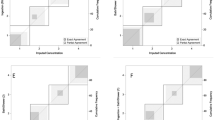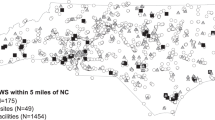Abstract
We conducted a sensitivity analysis of relative risk estimates using local area mean disinfection by-product exposures. We used Monte Carlo simulations to generate data representing 100 towns, each with 100 births (n=10,000). Each town was assigned a mean total trihalomethane (TTHM) exposure value (mean=45, SD=28) based on a variable number of sampling locations (range 2–10). True maternal TTHM exposure was randomly assigned from a lognormal distribution using that town's true mean value. We compared the effect of a 20 μg/l increase in TTHM exposure on the risk of small-for-gestational age infancy using the true maternal exposure compared to various weighting measures of the town mean exposures. The exposure metrics included: (1) unweighted town mean, (2) town mean weighted by the inverse variance of the town mean, (3) town mean weighted by the inverse standard deviation of the town mean, (4) town mean weighted by 1−(standard deviation of sites per town/mean across all towns), and (5) a randomly selected value from one of the sites within the town of residence. To estimate the magnitude of misclassification bias from using the town mean concentrations, we compared the true exposure odds ratios (1.00, 1.20, 1.50, and 2.00) to the mean exposure odds ratios from the five exposure scenarios. Misclassification bias from the use of unweighted town mean exposures ranged from 19 to 39%, increasing in proportion to the size of the true effect estimates. Weighted town mean TTHM exposures were less biased than the unweighted estimates of maternal exposure, with bias ranging from 0 to 23%. The weighted town mean analyses showed that attenuation of the true effect of DBP exposure was diminished when town mean concentrations with large variability were downweighted. We observed a trade-off between bias and precision in the weighted exposure analyses, with the least biased effects estimates having the widest confidence intervals. Effect attenuation due to intrasystem variability was most evident in absolute and relative terms for larger odds ratios.
This is a preview of subscription content, access via your institution
Access options
Subscribe to this journal
Receive 6 print issues and online access
$259.00 per year
only $43.17 per issue
Buy this article
- Purchase on Springer Link
- Instant access to full article PDF
Prices may be subject to local taxes which are calculated during checkout
Similar content being viewed by others
References
Bove F.J., Fulcomer M.C., and Klotz J.B., et al. Public drinking water contamination and outcomes. Am J Epidemiol 1995: 141: 850–862.
Bove F., Shim Y., and Zeitz P. Drinking water contaminants and adverse pregnancy outcomes: a review. Environ Health Perspect 2002: 110(Suppl 1): 61–74.
Chen W.J., and Weisel C.P. Halogenated DBP concentrations in a distribution system. J Am Water Works Assoc 1998: 90(4): 151–163.
Dodds L., King W., and Woolcott C., et al. Trihalomethanes in public water supplies and adverse birth outcomes. Epidemiology 1999: 10(3): 233–237.
Gallagher M.D., Nuckols J.R., and Stallones L., et al. Exposure to trihalomethanes and adverse pregnancy outcomes. Epidemiology 1998: 9(5): 484–489.
Graves C.G., Matanoski G.M., and Tardiff R.G. Weight of evidence for an association between adverse reproductive and developmental effects and exposure to disinfection by products: a critical review. Regul Toxicol Pharmacol 2001: 34: 103–124.
Hozalski R.M., Zhang L., and Arnold W.A. Reduction of haloacetic acids by FeO: implications for treatment and fate. Environ Sci Technol 2001: 35(11): 2258–2263.
King W.D., Dodds L., Armson B.A., Allen A.C., Fell D.B., and Nimrod C Exposure assessment in epidemiologic studies of adverse pregnancy outcomes and disinfection byproducts. J Expos Anal Environ Epidemiol 2004, doi: 10.1038/sj.jea 7500345.
Klotz J.B., and Pyrch L.A. Neural tube defects and drinking water disinfection by-products. Epidemiology 1999: 10(4): 383–390.
Kramer M., Lynch C., Isacson P., and Hanson J.W. The association of waterborne chloroform with intrauterine growth retardation. Epidemiology 1992: 3(5): 407–413.
Krasner S.W., McGuire M.J., Jacangelo J.G., Patania N.L., Reagan K.M., and Aieta E.M. The occurrence of disinfection by-products in US drinking water. J Am Water Works Assoc 1989: 81: 41–53.
Nieuwenhuijsen M.J., Toledano M.R., and Eaton N.E., et al. Chlorination disinfection by-products in water and their association with adverse reproductive outcomes: a review. Occup Environ Med 2000: 57: 73–85.
Rodriquez M.J., and Serodes J.-B. Spatial and temporal evolution of trihalomethanes in three water distribution systems. Water Res 2001: 35(6): 1572–1586.
SAS. Version 8.2. SAS Institute, Inc., Cary, NC, 2000.
Savitz D., Andrews K., and Pastore L. Drinking water and pregnancy outcomes in central North Carolina: source, amount, and trihalomethane levels. Environ Health Perspect 1995: 103(6): 592–596.
Singer P. Control of disinfection by-products in drinking water. J Environ Eng 1994: 120(4): 727–744.
Sohn J., Gatel D., and Amy G. Monitoring and modeling of disinfection by-products (DBPs). Environ Monit Assess 2001: 70(1–2): 211–222.
Stevens A.A., Moore L.A., and Miltner R.J. Formation and control of non-trihalomethane disinfection by-products. J Am Water Works Assoc 1989: 81(8): 54–60.
Waller K., Swan S.H., and DeLorenze G., et al. Trihalomethanes in drinking water and spontaneous abortion. Epidemiology 1998: 9(2): 134–140.
Waller K., Swan S.H., Windham G.C., and Fenster L. Influence of exposure assessment methods on risk estimates in an epidemiologic study of total trihalomethane exposure and spontaneous abortion. J Expos Anal Environ Epidemiol 2001: 11(6): 522–531.
Whitaker H., Nieuwenhuijsen M.J., Best N., Fawell J., Gowers A., and Elliott P. Description of trihalomethane levels in three UK water suppliers. J Expos Anal Environ Epidemiol 2003a: 13: 17–23.
Whitaker H.J., Nieuwenhuijsen M.J., and Best N.G. The relationship between water concentrations and individual uptake of chloroform: a simulation study. Environ Health Perspect 2003b: 111(5): 688–694.
Wright J.M., Schwartz J., and Dockery D.W. Effect of trihalomethane exposure on fetal development. Occup Environ Med 2003: 60(3): 173–180.
Wright J.M., Schwartz J., and Dockery D.W. The effect of disinfection by-products and mutagenic activity on birth weight and gestation duration. Environ Health Perspect 2004: 112: 920–925.
Acknowledgements
We thank Dr. Kevin Brand for his review of the manuscript and providing constructive comments and suggestions.
Author information
Authors and Affiliations
Corresponding author
Rights and permissions
About this article
Cite this article
Wright, J., Bateson, T. A sensitivity analysis of bias in relative risk estimates due to disinfection by-product exposure misclassification. J Expo Sci Environ Epidemiol 15, 212–216 (2005). https://doi.org/10.1038/sj.jea.7500389
Received:
Accepted:
Published:
Issue Date:
DOI: https://doi.org/10.1038/sj.jea.7500389
Keywords
This article is cited by
-
Comparison of Trihalomethane exposure assessment metrics in epidemiologic analyses of reproductive and developmental outcomes
Journal of Exposure Science & Environmental Epidemiology (2023)
-
Variability and predictors of changes in water use during pregnancy
Journal of Exposure Science & Environmental Epidemiology (2009)
-
Case control study of the geographic variability of exposure to disinfectant byproducts and risk for rectal cancer
International Journal of Health Geographics (2007)



